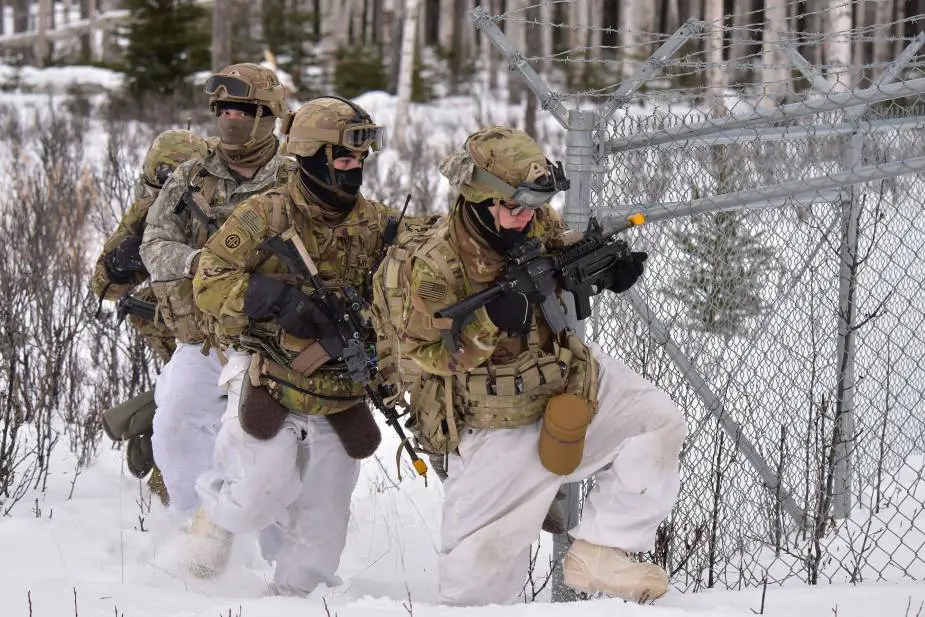US Army analyzing needs for Arctic operations
The U.S. Army is currently conducting a gap analysis as part of its new Arctic strategy to identify if any new equipment or training sites will be needed or expanded to prepare Soldiers for upcoming missions in extreme cold weather. Sean Kimmons, Army News Service, reports.
Follow Army Recognition on Google News at this link

Paratroopers from the 509th Parachute Infantry Regiment attack the Combined Arms Collective Training Facility in the Donnelly Training Area, Alaska, Feb. 11, 2021, as part of the Arctic Warrior exercise. (Picture source: John Pennell)
U.S. Army leaders recently announced the release of an Arctic strategy, which outlines how the service will support the Defense Department’s Arctic strategy published in 2019. It also discusses how Soldiers and units will be able to regain cold-weather capabilities after years of counterinsurgency operations in the Middle East.
Last February, Army officials carried out a gap analysis during the Arctic Warrior exercise in Alaska that examined any shortfalls of equipment required for the harsh region, said Col. J.P. Clark, chief of the strategy division within the Army G-3/5/7. Some equipment needs may be addressed in the next presidential budget, while long-term efforts, such as creating a multi-domain task force for the region, may take years to manifest, he said Wednesday during a media roundtable.
While there are no current plans to station more soldiers in Alaska, a decision on that could occur within a year. About 11,600 soldiers now serve in Alaska, which has the majority of permanent Army forces in the Arctic and sub-Arctic areas. “Those options are being worked for the Army senior leaders and we expect there will be an announcement for that probably later this year or even next,” Col. J.P. Clark said.
The strategy will also dig deeper into if training sites in Alaska, including the Northern Warfare Training Center, should be modified to meet requirements. “There are a number of training areas that provide a great opportunity to do this training in Alaska,” said Elizabeth Felling, a strategic planner in the Army G-3/5/7. “The Northern Warfare Training Center is the proponent for cold region training for the Army. How we utilize those training areas is something we’re really going to be looking at.”
Much of the training will be based on survival skills and being able to operate in one of the most extreme climates in the world, Clark said. “We want every soldier who is assigned to an Arctic-capable unit to have those basic capabilities,” he said.
The Army can also lean on its partnerships to better prepare its units for this type of warfare. “This is where we can gain a lot from our allies and partners,” Clark said. The “Canadians, Norwegians and Swedes have very impressive capabilities on how they build a unit to fight and win in this region.”
While subzero temperatures may impact operations, Soldiers can also face other challenges during missions. “We tend to kind of gravitate towards the extreme cold weather, but actually a lot of what we hear, in terms of mobility, it’s the summer months that are actually the most difficult,” Clark said. When frozen, waterways can be used as logistical routes for ground vehicles, especially due to the lack of roads in remote parts of Alaska. Those routes can then disappear when the weather warms up. The high latitudes of the region can also affect satellite coverage. “That is an underserved area for some of the space support that we depend on,” he said.
The north magnetic pole could even limit certain electronic items that may otherwise work elsewhere, he said, adding the Army plans to work with other military branches to find solutions.
Arctic-capable formations could also train with partners in mountainous parts of the world, Felling said. “When they’re properly trained and equipped we can ensure an arctic-capable formation [is ready] to meet the demands of our geographic combatant commanders around the globe, wherever those may be,” she said.


























